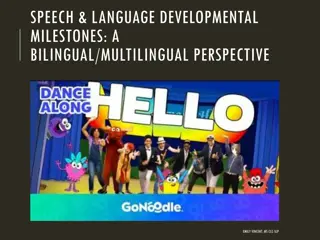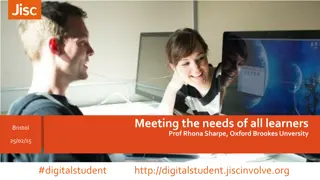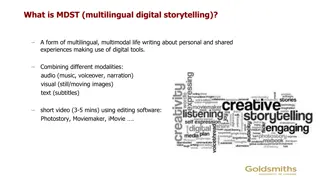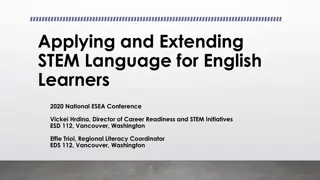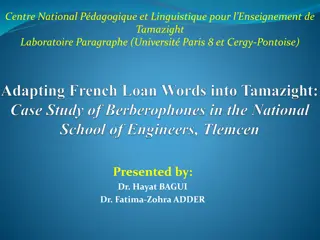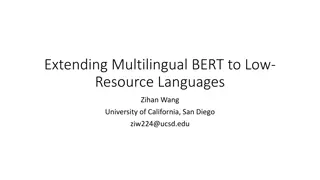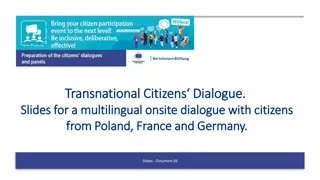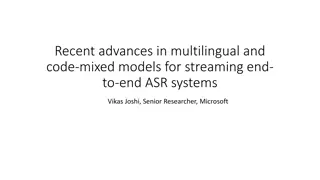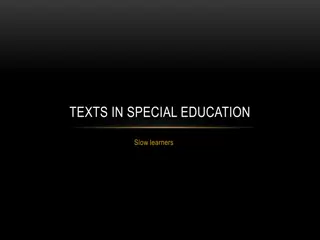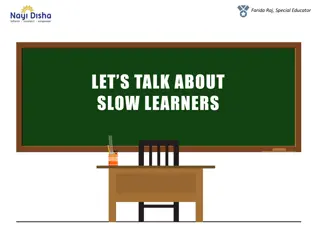
Exploring Special Education Evaluation for Multilingual Learners
Delve into considerations, definitions, and evaluation processes for multilingual learners in special education. Understand the importance of accurate identification to ensure appropriate services, as outlined in the 2021 Dear Colleague letter. Learn about bilingualism, trends in Colorado, and more.
Download Presentation

Please find below an Image/Link to download the presentation.
The content on the website is provided AS IS for your information and personal use only. It may not be sold, licensed, or shared on other websites without obtaining consent from the author. If you encounter any issues during the download, it is possible that the publisher has removed the file from their server.
You are allowed to download the files provided on this website for personal or commercial use, subject to the condition that they are used lawfully. All files are the property of their respective owners.
The content on the website is provided AS IS for your information and personal use only. It may not be sold, licensed, or shared on other websites without obtaining consent from the author.
E N D
Presentation Transcript
Considerations in Special Education Evaluation
Agenda and Outcomes Outcomes: Review terminology, definitions, and the English language development trajectory. Review processes and tools to consider when evaluating multilingual learners for special education services. I. Poll II. Context and Definitions III. Evaluation Tools IV.Student Scenarios
Poll 1. Do you have an ELD Coordinator? 2. Is language/multilingualism addressed in your evaluations/IEPs? 3. What is your ELD programming model? a. Dual Language Immersion/Bilingual b. ESL or ELD (e.g. pull-out groups or dedicated ELD block) c. Content Classes with Integrated ELD Support (e.g. Co-teaching or sheltered instruction) 4. Do you know where to find ACCESS scores? mentimeter
Context It is important to appropriately identify MLs with a disability so that they do not miss out on the services that they need. Conversely, MLs who are misidentified as having a disability receive special education services that they do not need. The 2021 Dear Colleague letter clearly establishes that teams must take level of English language proficiency into considerations when developing an IEP for a Multilingual Learner. (p.3)
Definitions Multilingual Learner (ML) English Learner (EL) Multilingual Learners (ML) Avoids labeling students in terms of the language they have yet to acquire Acknowledges students' first languages and cultures as strengths ELL, EL NEP, LEP FELL, FEP PHLOTE CLD Emerging Bilingual, Sequential, Simultaneous Reiterates the importance of literacy and proficiency in multiple languages CDE ML Dear Colleague August 2022
How do we define bilingualism/multilingualism? No universally agreed upon definition WIDA states - The term multilingual children is used to refer to culturally and linguistically diverse children who are learning two or more languages. Multilingual children are exposed to multiple languages in their homes, communities, and/or early care and education settings, and they develop and use language in dynamic ways. (WIDA, 2020)
Trends in Colorado o Multilingual students in Colorado schools have grown from 10,000 in 1980 109,809 in 2022 (12%) 13.6% of the U.S. population in 2021 was foreign-born In Colorado, 9.8% of the 2021 population was foreign-born o Currently over 280 different languages are spoken in the state, overwhelmingly Spanish speaking (81%) (Colorado Department of Education, English Language Development Guidebook, 2021) Currently there are 2,925 multilingual learners identified in the CSI portfolio (12.7%).
Please see the CDEs newly published guidance around Colorado House Bill 23-1263: ...for a child who is an English language learner, ...Upon the request of the child s parent, guardian, or legal custodian, the IEP team shall translate or contract with a translation service provider to translate the final IEP document into a written translation or an oral recording in the dominant language spoken in the home of the child s parent, guardian, or legal custodian.
Colorado House Bill 23-1263: IMPORTANT REMINDER: AUs have an independent obligation under federal law to provide language access to a parent with LEP regardless of whether their child is proficient in English or has been identified as a Multilingual Learner. Fact Sheet: IEP Document Translation: HB 23-1263: Language Access for Families with Limited English Proficiency Spanish Language Version: Traducci n de Documentos IEP: HB 23-1263: Acceso al Lenguaje para Familias de Habilidad Limitada del Ingl s
Interpretation and Translation Resource
ACCESS Colorado uses WIDA English language proficiency assessments. All Multilingual Learners identified as NEP and LEP, including students with disabilities, must participate in the state English language proficiency assessment system. The student participates in ACCESS for ELLs without an accommodation. The student participates in ACCESS for ELLs with an accommodation*. The student participates in Alternate ACCESS for students with the most significant cognitive disabilities. ACCESS is not an achievement test. It is a measure of growth.
1. List the primary language spoken in the home 2. List the students primary language 3. Yes = ONLY if student is identified NEP or LEP 4. Add ACCESS scores/Alternate ACCESS scores **Same info in Consideration of Special Factors (see next slide)
Questions about definitions or identification?
Dual Identification Disability Identification Suspicion, Referral, non-discriminatory evaluation, Comprehensive, Language proficiency considered EL Identification HLS, Interview Body of Evidence, Screener Language, Cultural, SES Influence - Educational Impact
Guiding Questions What evidence is there that the student has deficits in both languages and across various settings? Is it possible that deficits exhibited by the student are accounted for by limited experiences in using the language? How does the level of proficiency in English impact instruction? Is the student demonstrating sufficient rate of progress in the skill in question as compared to their peers of similar background and culture? Has there been sufficient multi-tiered systems of support given to help the student access the curriculum?
Possible Identifiers The student s rate of progress is below the expected rate for LEP students. The student s academic skills are significantly delayed. The parent regard the student as different or delayed. The student does not exhibit mastery of academics at their language and developmental level even after carefully planned and administered targeted interventions.
When MLs are being evaluated Things to think about/start with: 1. Ethnographic interview 1. Observations of student a. Student Oral Language Observation Matrix (SOLOM) 1. Person knowledgeable about language acquisition- consult with IEP team before/during/after meeting a. ACCESS information 2-3 years of data (is there growth?) Maybe add chart? i. b. WIDA s Proficiency Level Descriptors c. Who will speak about at meeting?
Resources: How do I rule out limited English proficiency, culture, and socioeconomic status as primary contributors to a student s educational challenges? 1. Tennessee Ethnographic Interview 2. Adams 12 Five Star Schools Ethnographic Interview Full Form (A form that is used in the RtI process as well as in the SpEd process) 3. Adams EI En Espa ol 4. Mesa County Valley School District 51 Expanded Home language Survey English 5. Mesa County Valley School District 51 Expanded Home language Survey Espa ol ** this should be completed with the parent (Native Speaker if possible)
Activity: Student Scenarios 1 minute: Read scenario 2 minutes: Independent think time 10 minutes: Discussion 1. What did you notice? (Think assets first) 2. What are next steps for the Special Education teacher or coordinator? 2 minutes: Wrap up; Choose who will share
Next Steps 1. Interview (use a template/build one) 2. Observations of student 3. Familiarize with ACCESS scores a. ELD Coordinator 4. How can you take this information back to your school? Training to come: -Dynamic Assessment






